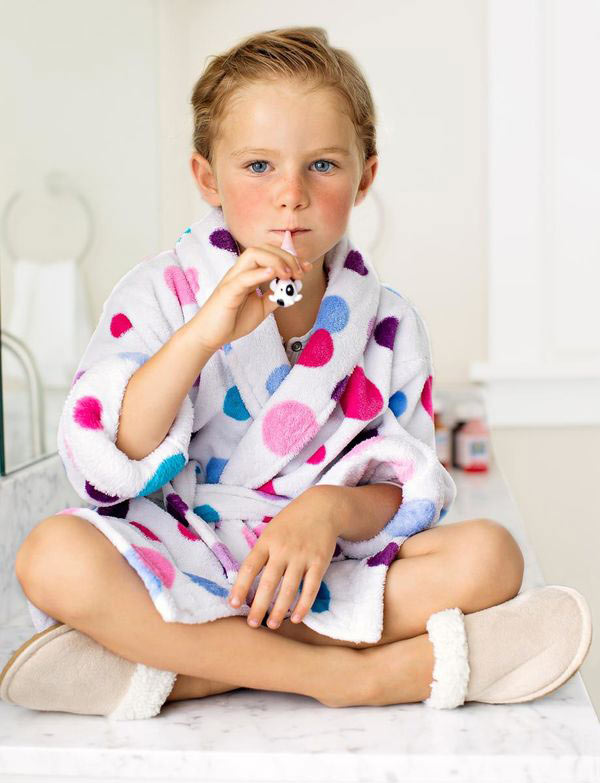If you're about to freak out over a temp of 102°F, take a deep breath and remember this smart advice from Michael Steiner, MD, a dad of two and associate professor of pediatrics at the University of North Carolina at Chapel Hill School of Medicine.
1. The fever isn't the illness.
Parents often concentrate more on lowering the temp than figuring out what’s behind it. The most common misconception is that fever is dangerous, but that’s almost never the case. Fevers are simply the body’s response to an underlying infection (germs can’t thrive in high temperatures). For kids, the infection is usually viral like a common cold or stomach bug. But a child can have a fever without any other apparent symptoms. For example, if an older baby or a toddler has a high fever (103°F or more) for several days and then develops a full-body rash, she might have roseola. While contagious during the fever phase, this is a common virus in young kids that you can easily treat at home with acetaminophen or ibuprofen.
2. For an infant, 100.4°F is the number to know.
If your child is under 3 months, this is the rectal-temperature reading that means you should call the doc. Why not 99°F? Body temp is on a spectrum, and there’s a range in which most healthy people fall. But for babies, 100.4°F is the cutoff that signals something might be wrong. A baby’s immune system is still developing, so while it’s probably just a virus, a doctor needs to rule out a bacterial infection.
3. For bigger kids, trust your gut.
If your child is 3 months or older, has a fever of 102°F or higher, and shows signs of cold or flu, give acetaminophen or ibuprofen for the fever and hang tight. A lukewarm bath may also bring down the fever and keep her comfortable. Liquid on the skin helps the body equilibrate, just like sweating when you exercise.
Most viruses go away in three or four days; if your child’s fever lasts longer, call the doctor. And always call if your child isn’t making wet diapers (which could be a sign of serious dehydration), won’t respond to your voice, or struggles to breathe (a possible sign of RSV or croup). Can’t ride out a low-grade fever without contacting your pediatrician? No doc will penalize you for getting in touch, even if you don’t go in to the office.
4. Febrile seizures are scary—but rare.
A rapid change in a child’s body temperature can trigger a seizure, which is why most febrile seizures happen within 24 hours of a fever’s onset. Between 2 and 5 percent of kids experience one before age 5, but the risk peaks during the second year of life.
How will you know it’s a seizure? Your child’s whole body will shake (usually for a few minutes) and he won’t be able to respond to voices. After the shaking stops, he’ll be confused for about half an hour. Thankfully, most kids who get seizures don’t have a dangerous infection and outgrow the tendency by age 6. But a kid’s first one definitely warrants a trip to the E.R.
5. All you need is a regular digital thermometer.
Doctors say basic is best. Proper use depends on a child’s age: In infants, a rectal temperature is the gold standard. (Have your pediatrician demonstrate at your next visit.) It’s the most accurate method for older babies, too, but if your child won’t stay still, sticking a thermometer under his arm works well. Try the oral method once he can hold one under his tongue with his mouth closed.
如果您发现宝宝体温升高到102°F(38.9℃)的温度不知如何是好,请深吸一口气,并记住Michael Steiner博士,北卡罗莱纳大学教堂山分校的两位父亲和儿科副教授的建议医学。
1.发烧不是疾病。
家长通常更关注降低温度,而不是找出背后的原因。 最常见的误解是发烧很危险,但几乎从未如此。 发烧只是身体对潜在感染的反应(细菌无法在高温下茁壮成长)。 对于孩子来说,感染通常像感冒或胃病一样是病毒。 但是一个孩子可以发烧,但没有任何其他明显的症状。 例如,如果一个较大的婴儿或学步儿童在几天内发高烧(103°F/43℃或以上),然后出现全身皮疹, 她可能会有玫瑰疹 。 虽然在发烧阶段有传染性,但这对于年幼的孩子来说是一种常见病毒,您可以在家中用对乙酰氨基酚或布洛芬轻松治疗。
2.对于婴儿,100.4°F/38℃是临界点的数字。
如果你的孩子3个月以下,这是直肠温度读数,这意味着你应该打电话给医生。 为什么不是99°F/37℃? 体温在一个正常范围内,并且大多数健康人都有一个范围。 但对于婴儿来说,100.4°F/38℃是指示某些事情可能出错的临界点。 婴儿的免疫系统仍在发展,虽然它可能只是一种病毒,但医生需要排除细菌感染。
3.对于更大的孩子,相信你的直觉。
如果您的小孩年龄在3个月或以上,发烧发烧达到102°F/38.9℃或更高,并且有感冒或流感迹象 ,请给予对乙酰氨基酚或布洛芬治疗发烧。 温水浴也可能会降低发烧并保持舒适。 皮肤上的液体有助于身体平衡,就像运动时出汗一样。
大部分病毒在三到四天内就会消失; 如果您孩子的发烧持续时间更长,请致电医生。 如果你的孩子没有尿湿尿布(这可能是严重脱水的迹象),不会对你的声音做出反应,或者难以呼吸( RSV或哮喘的可能征兆)。 如果没有联系您的儿科医生,就不能安然度过, 请联系医生,即使不去医院。
4.热性惊厥是可怕的 - 但很少见。
儿童体温的快速变化会引发癫痫发作,这就是为什么大多数热性惊厥在发烧发作24小时内发生。 2%到5%的孩子在5岁之前经历一次,但风险在人生第二年达到高峰。
你怎么知道这是癫痫发作?你的孩子的整个身体会颤抖(通常会持续几分钟),他将无法对声音做出反应。在晃动停止后,他会被迷惑大约半个小时。值得庆幸的是,大多数患癫痫的孩子不会有危险的感染,而且在6岁的时候就会逐渐消失。但是一个孩子的第一次绝对值得去急诊室。
5.所有你需要的是一个普通的数字温度计。
医生说最普通的是最好的。 正确使用取决于孩子的年龄:在婴儿中,直肠温度是黄金标准。 (您的儿科医生是否在您下次访问时展示)对于较大的婴儿来说,这也是最准确的方法,但如果您的孩子不能保持静止,将温度计粘在手臂下效果很好。 嘴巴闭合后,可以尝试口腔方法,当然是在他能保持不说话的情况下。


